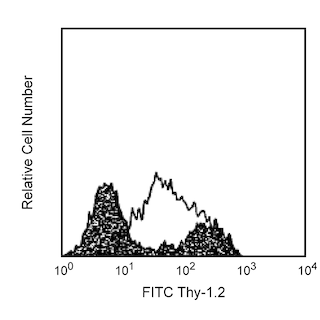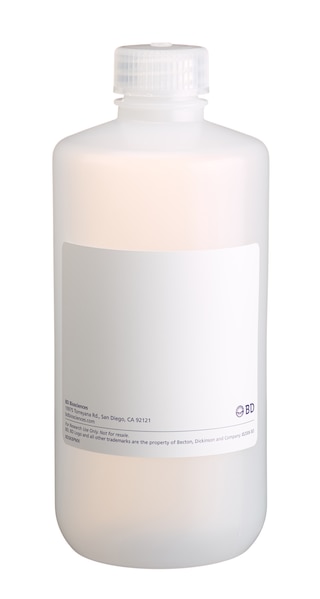Old Browser
Looks like you're visiting us from {countryName}.
Would you like to stay on the current country site or be switched to your country?




Flow cytometric analysis of CD1d expression on mouse thymocytes. BALB/c mouse thymocytes were preincubated with Purified Rat Anti-Mouse CD16/CD32 antibody (Mouse BD Fc Block™) (Cat. No. 553141/553142). The cells were then stained with either Alexa Fluor® 647 Rat IgG2b, κ Isotype Control (Cat. No. 557691; dashed line histogram) or Alexa Fluor® 647 Rat Anti-Mouse CD1d antibody (Cat. No. 564706; solid line histogram). The fluorescence histograms were derived from gated events with the forward and side light-scatter characteristics of viable thymocytes. Flow cytometric analysis was performed using a BD LSRFortessa™ Cell Analyzer System.


BD Pharmingen™ Alexa Fluor® 647 Rat Anti-Mouse CD1d

Regulatory Status Legend
Any use of products other than the permitted use without the express written authorization of Becton, Dickinson and Company is strictly prohibited.
Preparation And Storage
Product Notices
- Since applications vary, each investigator should titrate the reagent to obtain optimal results.
- An isotype control should be used at the same concentration as the antibody of interest.
- Caution: Sodium azide yields highly toxic hydrazoic acid under acidic conditions. Dilute azide compounds in running water before discarding to avoid accumulation of potentially explosive deposits in plumbing.
- Alexa Fluor® 647 fluorochrome emission is collected at the same instrument settings as for allophycocyanin (APC).
- The Alexa Fluor®, Pacific Blue™, and Cascade Blue® dye antibody conjugates in this product are sold under license from Molecular Probes, Inc. for research use only, excluding use in combination with microarrays, or as analyte specific reagents. The Alexa Fluor® dyes (except for Alexa Fluor® 430), Pacific Blue™ dye, and Cascade Blue® dye are covered by pending and issued patents.
- Alexa Fluor® is a registered trademark of Molecular Probes, Inc., Eugene, OR.
- For fluorochrome spectra and suitable instrument settings, please refer to our Multicolor Flow Cytometry web page at www.bdbiosciences.com/colors.
- Please refer to www.bdbiosciences.com/us/s/resources for technical protocols.
Companion Products





The 1B1 monoclonal antibody specifically binds to mouse CD1d, a 48-kDa glycoprotein with structural homology to major histocompatibility complex (MHC) class I molecules. The structure, expression, and functions of CD1 antigens are complex and have been reviewed. MAb 1B1 detects CD1d at varying levels on most types of bone marrow and peripheral leukocytes and on epithelial, dendritic, and lymphoid cells in the thymus. It appears to recognize CD1d only in association with β2m. CD1d has been reported to be expressed by gastrointestinal tract epithelium and in the cytoplasm of hepatocytes via immunohistochemical staining of frozen sections with mAb 3C11 (Cat. No. 559871, for the purified antibody), suggesting a possible role for CD1d in mucosal immunity. However, CD1d expression was not detectable via flow cytometry on intestinal epithelial cells in studies using the anti-CD1d mAbs 3C11, 1B1, and 9C7. The 1B1 antibody competes with mAb 3C11 in binding to mouse splenocytes.
Development References (7)
-
Amano M, Baumgarth N, Dick MD, et al. CD1 expression defines subsets of follicular and marginal zone B cells in the spleen: beta 2-microglobulin-dependent and independent forms. J Immunol. 1998; 161(4):1710-1717. (Clone-specific: Flow cytometry). View Reference
-
Bleicher PA, Balk SP, Hagen SJ, Blumberg RS, Flotte TJ, Terhorst C. Expression of murine CD1 on gastrointestinal epithelium. Science. 1990; 250(4981):679-682. (Biology). View Reference
-
Brossay L, Jullien D, Cardell S, et al. Mouse CD1 is mainly expressed on hemopoietic-derived cells. J Immunol. 1997; 159(3):1216-1224. (Immunogen: Blocking, Flow cytometry, Immunohistochemistry, Immunoprecipitation, Inhibition). View Reference
-
Porcelli SA, Modlin RL. The CD1 system: antigen-presenting molecules for T cell recognition of lipids and glycolipids. Annu Rev Immunol. 1999; 17:297-329. (Biology). View Reference
-
Roark JH, Park SH, Jayawardena J, Kavita U, Shannon M, Bendelac A. CD1.1 expression by mouse antigen-presenting cells and marginal zone B cells. J Immunol. 1998; 160(7):3121-3127. (Clone-specific: Blocking, Flow cytometry). View Reference
-
Sydora BC, Brossay L, Hagenbaugh A, Kronenberg M, Cheroutre H. TAP-independent selection of CD8+ intestinal intraepithelial lymphocytes. J Immunol. 1996; 156(11):4209-4216. (Clone-specific: Flow cytometry). View Reference
-
Szalay G, Ladel CH, Blum C, Brossay L, Kronenberg M, Kaufmann SH. Cutting edge: anti-CD1 monoclonal antibody treatment reverses the production patterns of TGF-beta 2 and Th1 cytokines and ameliorates listeriosis in mice. J Immunol. 1999; 162(12):6955-6958. (Clone-specific: Blocking, Flow cytometry, In vivo exacerbation). View Reference
Please refer to Support Documents for Quality Certificates
Global - Refer to manufacturer's instructions for use and related User Manuals and Technical data sheets before using this products as described
Comparisons, where applicable, are made against older BD Technology, manual methods or are general performance claims. Comparisons are not made against non-BD technologies, unless otherwise noted.
For Research Use Only. Not for use in diagnostic or therapeutic procedures.
Report a Site Issue
This form is intended to help us improve our website experience. For other support, please visit our Contact Us page.